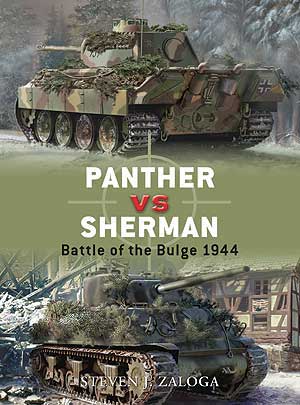Author: Steven J. Zaloga
- ISBN Number 978-1-84603-292-9
- Item Number: Osprey Dual Engage the Enemy Series
Review by Bill Curtis

 Our thanks to Osprey Publishing for supplying our review copy. Get this excellent reference book here now at: www.ospreypublishing.com
Our thanks to Osprey Publishing for supplying our review copy. Get this excellent reference book here now at: www.ospreypublishing.com
View the pages in more detail by clicking on the images below:
Initial assessment…
This is not a new release but one I missed and as it’s a Panther related subject I had to add it to my collection. The book in the now familiar soft cover format with 80 Pages and has a lot of pictures (47) as well as illustrations and maps.
The contents of the book are as follows:
- Introduction
- Chronology
- Design and Development
- Technical Specifications
- The combatants
- The strategic Situation
- Combat
- Statistics and Analysis
- Conclusion
- Bibliography and Index.
The Chronology takes the reader through development to production end of both tanks in a two page spread which includes the Ardennes Offensive.
The next two chapters deal with the design and development followed by the technical specs of both vehicles. In these are illustration of the tank and a cut way of both turrets showing the internal layout.
The Combatants chapter explain the crew positions, training and also includes cutaways of the tanks showing these positions. This chapter also includes a page on German tank aces, Ernst Barkmann and Fritz Langanke, while the US didn’t favour the ace system the highest scoring tanker, Col Creighton Abrams, is sighted with a mini biopic.
The next chapter deals with the strategic situation in 1944 and there is a map illustrating the attack in Dec 44.
Combat is the heart of the book as this is really “The Duel” involving both vehicles with the setting in the Battle of the Bulge and I found this an interesting assessment of the use of both vehicles.
The book deals with the relative merits and down sides of each vehicle and while the Panther had a superior gun and on paper should have been the better vehicle Steven points out other factors which had a bearing on the operational use of the vehicle such as poor crew training, late war armour quality, fuel shortages, manufacturing quality control, servicing /repairs and spare parts and finally the quantity v quality debate.
Conclusion…
For a small book this has a lot of information which is set out in an easy to read and logical way. I like the authors style of writing which is clear and concise and his conclusions are well researched and thought out. The book is not an in-depth study as limited by the size of the book but it gives a good introduction of the operational and technical pros and cons for both vehicles and there use during this time frame.
Basically it comes down to first to see, first to fire and first to score the kill shot which depended on a whole raft of things previously stated and also includes the tactical use of the tanks.
This is a very nice account of the fighting during the Ardennes Offensive covering the successes and failures of both vehicles which I thoroughly enjoyed reading.
Highly Recommended
The book was supplied by Osprey Books for review and though this is not a new title it is one that deserves to be read and will no doubt appeal to the historian as well as the model maker as a source of inspiration.
Bill C.










